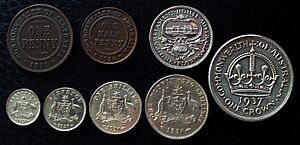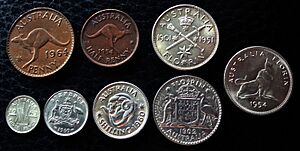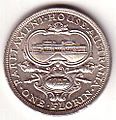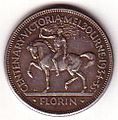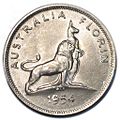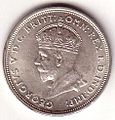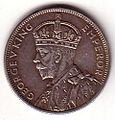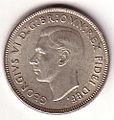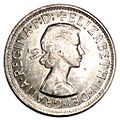Coins of the Australian pound facts for kids
Before 1966, Australia used a money system similar to what the British used. These coins are called pre-decimal Australian coins. Australia started making its own coins in 1901. This happened after the different British colonies like Queensland and New South Wales joined together to form the country of Australia. This new power meant Australia could create its own official money, called legal tender, instead of each colony doing it separately.
Even though Australia could make its own coins from 1901, British coins were still used for a while. The first Australian silver coins were introduced in 1910. These included florins, shillings, sixpences, and threepences. All these new coins had a picture of Edward VII, who was the King at the time. A year later, in 1911, Australian pennies and half-pennies also started being used. Unlike in New Zealand, Australia did not have a "half-crown" coin. Gold coins called "sovereigns" stopped being made in Australia in 1931. A special coin called a crown, which was worth five shillings, was made in 1937 and 1938.
On 14 February 1966, Australia changed its money system to decimal currency. This meant that the old pounds, shillings, and pence were replaced with dollars and cents. The new system made it easier to count money. For example, two Australian dollars were worth one Australian pound.
Contents
Australia's Old Money System (£sd)
Australia's old money system was based on pounds (£), shillings (s), and pence (d). This system was used for many years. Before Australia started making its own coins, the British government allowed two colonies, New South Wales and Victoria, to make silver and bronze coins. They had mints (places where coins are made) in Sydney and Melbourne.
Changes to Coin Metal
During World War II, making coins was very expensive. Because of this, in 1946, the amount of silver in the coins was reduced. Before 1946, coins were made of 92.5% silver. After 1946, they only had 50% silver. This change lasted until Australia switched to decimal money in 1966.
One coin that collectors really want is the 1930 penny. It is very rare and valuable.
Australian Coins and Their Designs
Australian coins had different designs over the years. These designs often showed the King or Queen of England at the time. They also featured Australian symbols.
- Halfpenny (½d) and Penny (1d):
* These coins were made of Bronze. * Early designs showed King George V. The back of the coin had the words "ONE HALF PENNY" or "ONE PENNY" inside a circle of beads. It also said "COMMONWEALTH OF AUSTRALIA" and the date. * Later designs featured King George VI. The back of these coins showed a Kangaroo. * Even later, Queen Elizabeth II appeared on the front. The kangaroo design stayed on the back.
- Threepence (3d) and Sixpence (6d):
* These smaller silver coins were first made of Sterling silver (92.5% silver). * The first coins had King Edward VII on the front. The back showed the 1908 Australian coat of arms with the motto "ADVANCE AUSTRALIA". * Later, King George V and King George VI were on the front. The threepence changed its back design to show three ears of wheat. The sixpence kept the coat of arms design. * After 1946, these coins were made with less silver (50% silver, plus copper, zinc, and nickel). Queen Elizabeth II appeared on the front of later coins.
- Shilling (1/-) and Florin (2/-):
* These were also silver coins, first made of Sterling silver. * Early shillings and florins had King Edward VII or King George V on the front. The back showed the 1908 Australian coat of arms. * Later shillings, with King George VI or Queen Elizabeth II on the front, featured a ram's head on the back. * Florins had various special designs. For example, some showed the Old Parliament House or celebrated the centenary of Victoria. Others featured the Commonwealth of Australia arms or a lion and kangaroo. * Like the smaller silver coins, these also had their silver content reduced to 50% after 1946.
- Crown (5/-):
* This was a large silver coin, worth five shillings. * It was made of Sterling silver. * The front showed King George VI. The back featured the Imperial crown with the date below it. It also said "COMMONWEALTH OF AUSTRALIA" and "ONE CROWN". These were only made in 1937 and 1938.
All these coins stopped being used on 14 February 1966 when Australia switched to decimal currency.
Special Commemorative Coins
Some pre-decimal coins were made to celebrate important events. These are called commemorative coins.
Florin (2 shillings) Commemorative Coins
-
This 1927 florin celebrated the opening of the original Parliament House in Canberra.
-
This 1934-35 florin marked 100 years since the founding of Victoria and the city of Melbourne.
-
This 1951 florin celebrated 50 years of the Commonwealth of Australia.
-
This 1954 florin was made to remember the visit of Queen Elizabeth II to Australia.
-
The front of the 1927 florin, showing King George V.
-
The front of the 1951 florin, showing King George VI.
-
The front of the 1954 florin, showing Queen Elizabeth II.


